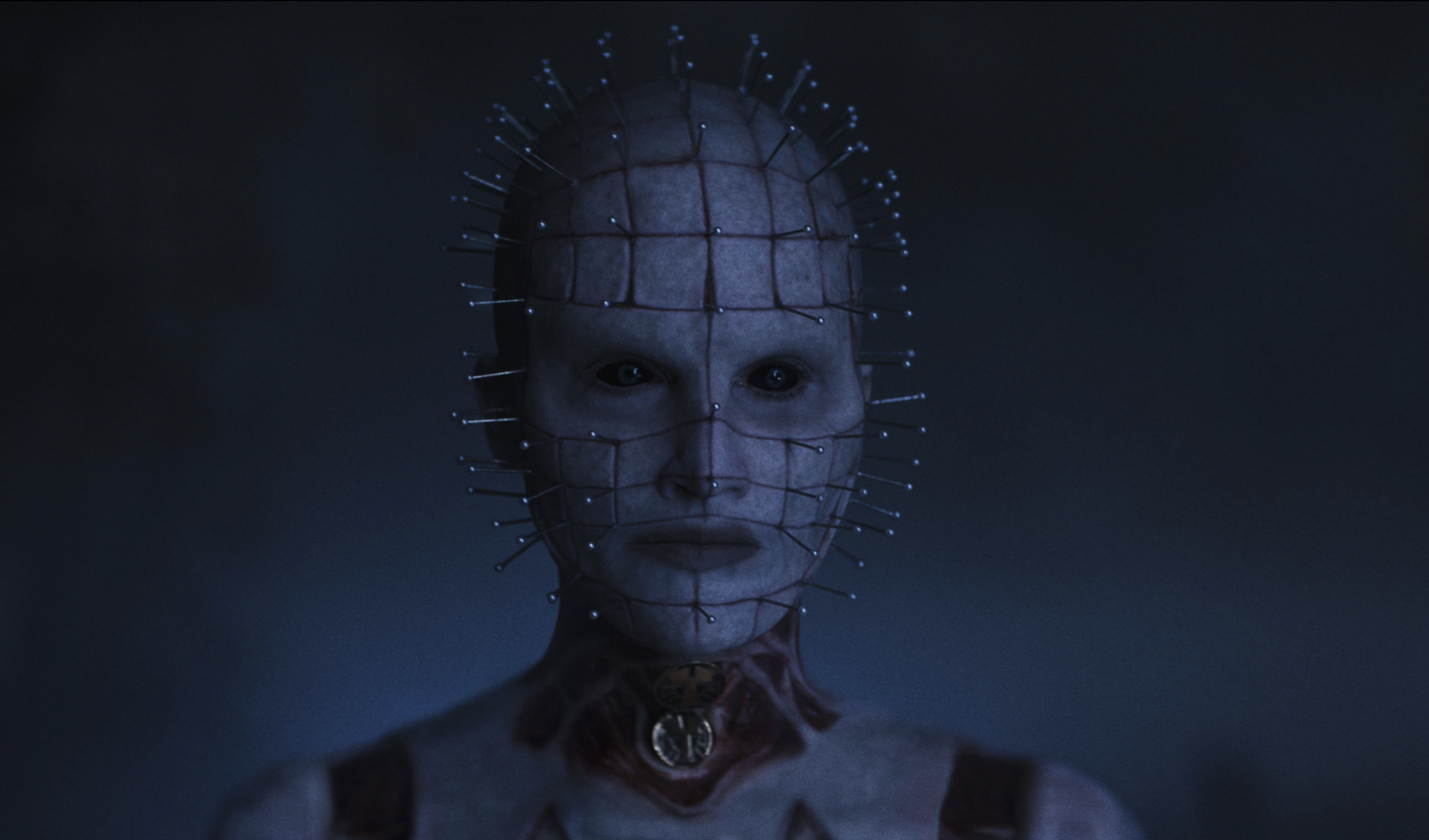After a wait of more than 30 years, our favorite “explorers in the further regions of experience” have made their sinister return to the screen, just in time for the Halloween season. On September 28, 2022, Hulu released Hellraiser (2022), a revival of Clive Barker’s cult classic of the same name. Hellraiser (2022) falls in line as another entry into the saturated club of modern horror remakes, leaving horror enthusiasts to ask the question of whether this film can stand out amongst the crowd. Fear not, because I’m pleased to report that despite its few shortcomings, Hellraiser (2022) breathes new, youthful life into an older franchise while successfully reimagining the original films for a modern horror context.
Directed by David Bruckner, Hellraiser (2022) completely reboots the franchise, narratively departing from the characters and plotlines of the original trilogy while keeping the core elements and themes at the heart of the earlier movies intact. The story follows Riley (Odessa A’zion), a young woman struggling with addiction and purpose, who discovers and opens a mysterious, otherworldly puzzle box. This box, known colloquially as the “Lament Configuration” amongst fans, beckons the invasion of the Cenobites—demonic humanoids from a hellish dimension that revel in sadism and pain. Riley soon learns that once the Cenobites have been invited to our realm, they do not leave so easily, as their emergence begets a wave of suffering and anguish for Riley and her friends.
Fans of the Hellraiser franchise will be relieved to see the return of the puzzle box and the Cenobites; in fact, the use of these now-iconic features is perhaps one of the best aspects of the film because Bruckner modernizes these features, rather than simply recreating them. Whereas the original puzzle box was just a MacGuffin which permitted the Cenobites to enter our realm, Bruckner’s modern version enables people to sacrifice others to the demons and claim one of their gifts in the process. Furthermore, Bruckner’s reinterpretation of the Cenobites heightens the unsettling attributes of their alien forms while staying true to Barker’s aesthetic. In this film, the Cenobites sport beady eyes, glossy skin, and mangled anatomies—characteristics which are familiar yet feel like a fresh coat of paint. These improvements are perhaps best illustrated by Bruckner’s depiction of the main Cenobite, known amongst fans by the nickname “Pinhead,” portrayed in the revival by the amazing actress Jamie Clayton. Bruckner’s design choices combined with Clayton’s composed, resolute demeanor create a terrifying villain that induces a sense of hopelessness and dread in audiences.
Clayton’s role as Pinhead is more than just a fantastic casting decision for the film. More importantly, it represents just one of the refreshing steps that Bruckner took to portray queer characters and themes in an authentic way.
Because Clayton is a trans actress, her casting as the iconic Pinhead is already a divergence from the original film, where Pinhead was played by a man. What makes the casting of Clayton genuine, rather than exploitative for diversity, is that Pinhead could truly have been played by anyone. Yet, Bruckner chose to cast Clayton in the role, giving her the opportunity to express her talent as an actress while not casting her solely because of her trans identity. Moreover, Bruckner does not highlight the fact that Pinhead is played by a trans actress in any particular way. Had this been an important element to the character’s identity, this disingenuous representation might have distracted away from Clayton’s performance while simultaneously feeding into the negative villainization of trans people in the media. Instead, Bruckner takes a more subtle approach with his reinvention of Pinhead, heightening the more androgynous features of the character while steering away from specificities about the character’s gender. This approach gave Clayton the freedom to make the character her own, and she does a damn good job at it. What we end up with is a villain that makes audiences cower in their seats.
The portrayal of queer talent does not end with Clayton. Not only are many side characters played by queer actors, but two important male characters—Riley’s brother Matt (Brandon Flynn) and his boyfriend Colin (Adam Faison)—are openly in a relationship in the film. The horror industry is notorious for exploiting gay characters solely for comedic relief and killing them off before the second act, always the first kill but never the final girl. Yet, Bruckner defies these stereotypes with Matt and Colin, because their characters are fleshed-out and present throughout the film. Their queerness is explicitly expressed, but not fetishized, an important distinction when it comes to queer representation.
Representing queerness authentically in this movie is essential because the original Hellraiser had inherently queer themes. Clive Barker, the original director, is an openly gay man and has been transparent about the fact that Hellraiser was partially inspired by the culture of sadomasochism he observed in a New York gay club. In the 1980s, Barker was not able to explicitly reveal his inspiration, but its echoes are seen in the leather-bound costumes that the Cenobites wear and their nontraditional tastes for pleasure and pain indiscriminately. Bruckner amplifies these themes which were once only hinted at, making it very clear that the S&M culture present in the underground queer community in New York is an influence for these films. Chains suspending people in mid-air, wires binding victims in place—it’s all on display in Hellraiser (2022). Fascinatingly, because BDSM is much less taboo today than it was in the ‘80s, Bruckner had to push these themes further to maintain the films’ boundary-pushing edge. For example, rather than wear the same leather costumes from the original films, the revived Cenobites don uniforms made from their own mutilated and warped flesh, a sickening but welcome addition. While the original’s queerness was only hinted at, Hellraiser (2022) places these themes front and center, realizing the potential which Barker could not.
While this film does an exemplary job at reimagining the Hellraiser universe, the movie itself struggles on other fronts, tempering its would-be fiery entrance on the horror scene. Perhaps the film’s biggest downfall is that it just does not terrify its audience as much as the original Hellraiser did. The new and improved design of the Cenobites is certainly frightening, and one of the tortuous deaths did make me wince; but mostly, this revival solely consists of off-screen deaths and CGI gore. This “implied horror” just doesn’t compare to the truly horrific images from the original Hellraiser (1987), which utilized practical effects and close-up shots to show hooks digging into skin and flayed bodies. If you’re looking for a throwback to the gore-fest thrillers of the 1980s, Hellraiser (2022) will not be for you.
Another disappointing part of this film is its treatment of the main character, Riley. While Odessa A’zion’s performance as Riley is wonderful, the way the writers handled her character arc left much to be desired (spoiler warning ahead).
Riley is characterized as a young woman whose decadence and indulgence leads her to destroy the frayed relationships in her life. She thinks that the way to solve her problems is to dig her holes even deeper, but this behavior only spawns more complications. As a result of Riley’s carelessness, her brother disappears to the puzzle box, forcing her to confront the fact that her self-destructive personality is harming the people around her. This internal conflict is embodied by her narrative goal: to harness the Cenobites’ gift to resurrect her brother. The only way to earn their gift, however, is to sacrifice other people to the puzzle box, presenting Riley with an impossible decision.
The result one would expect from this dilemma is much akin to Julia’s (Clare Higgins) arc from the original Hellraiser (1987), wherein she sacrifices people to bring her lover, Frank (Sean Chapman), back to life. Therefore, the viewer might expect Riley to similarly sacrifice others to get her brother back—a further extension of her nihilistic behavior. While the writers seem to hint at this possibility initially, they then entirely remove Riley’s agency by making all of her sacrifices accidental. By the climax of the film, Riley is supposed to live with the fact that she allowed all her friends to die for nothing; however, because none of the deaths were Riley’s fault, this depth is lost. Audiences are subsequently left to ponder, “What does she have to feel sorry for?”
Despite the minute blemishes present, Hellraiser (2022) is a captivating exhibition of horror that stays true to the source material while adding so much more. Bruckner has not only satiated older fans that have been yearning for another round of the malicious Cenobites, but also opened the door for newer fans who might see themselves in the heroes and villains of this film. Either way, Hellraiser (2022) will go down as an exceptional lesson in how to do a horror remake.





